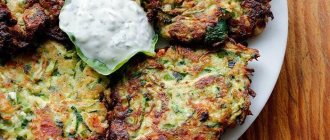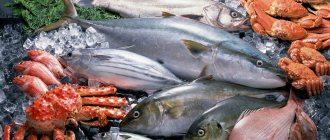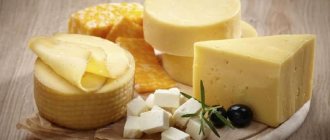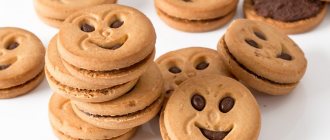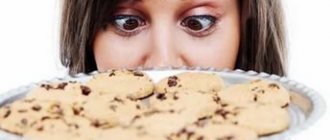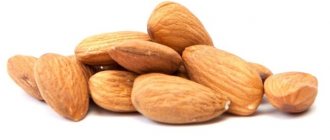Right choice
A nursing mother can eat durum pasta; to choose the “right” one, you need to know the following:
- high-quality pasta is always hermetically packed, cardboard box or translucent soft packaging;
- ingredients – water, flour; products do not crumble, are not dusty with flour; color - from yellow to creamy, bright color is a sign of paint in the products, very white ones are made from flour with bleach, mothers nursing a child should not eat them;
- the sound when stirring is muffled, they do not ring;
- when cooking in water, there are no traces of white or yellow paint or cloudy suspension;
- pasta does not boil over and does not turn into porridge;
- products of dense homogeneous structure;
- ready-made cream-colored paste;
- the taste is pleasant creamy without a bitter aftertaste.
How to buy a quality product?
Even when buying the most ordinary cones or spaghetti, you need to approach their purchase responsibly so that you buy a high-quality and healthy product. If you want to purchase such products, then follow the recommendations given below:
- First, you should read what is written on the package. The right choice can be made simply by reading all the information.
- Healthy pasta should consist only of water and durum wheat flour.
- It is necessary to carefully inspect the pasta packaging. If crumbs were found inside it, this means that the product was made from low-quality raw materials.
- A quality product can be recognized by its color. The product is made from high-quality raw materials and has a uniform, light yellow tint. The bright color of the pasta indicates the addition of dyes.
- Today, pasta of different shades is very common. They were invented for children to increase interest in food. Natural dyes are allowed. These are spinach, beet or carrot juices.
- When pasta is cooked, the water should be clear or slightly cloudy; yellow color indicates dyes in the product.
- It is necessary to prepare pasta while breastfeeding in strict accordance with the instructions. A good product does not stick together or become overcooked.
- When purchasing a product, you need to choose one that matches the price and quality. A good product cannot have a very low price, but you shouldn’t buy expensive pasta just because of a well-known brand either. You can select a product at a price that will be slightly above average.
How to eat pasta during lactation
A woman who is breastfeeding is allowed to eat any type of pasta. But at the same time, they should not eat instant pasta, because it contains a lot of spicy additives and chemicals. Such pasta is harmful both for a woman and for a child, therefore it leads to intestinal disorders and causes an allergic reaction in the baby.
In order not to harm the body of the child and mother, it is recommended to follow some rules:
- In the first days after discharge, you should not eat pasta with meat, such as navy pasta. It is better to eat vermicelli spaghetti or horns with olive oil.
- Pasta can be eaten a week after being discharged from the hospital, without adding other ingredients, limiting yourself to a salad of boiled beets or adding a little cottage cheese and herbs.
- A nursing woman should consume up to 170-200 grams of pasta per day, and 400 grams per week.
- You cannot eat fried pasta; it is better to eat it boiled or baked.
- It is not recommended to eat pasta with mushrooms before 6 months of breastfeeding, as mushrooms can have a bad effect on the baby’s body.
- It is also not advisable to eat pasta with seafood, because it is bad for the newborn’s intestines.
- It is allowed to eat soups with pasta.
- For the first time after giving birth, a woman is recommended to try a small portion of naval pasta, and then monitor the condition of the infant. If no changes are observed in the baby’s condition, then you can increase the portion.
Pasta recipes for nursing mothers
Navy pasta recipe for a nursing mother after 4 months of a baby’s life in a slow cooker:
- Take 400 grams of pasta “horns” or “bows” and 300 grams of chicken or ground beef prepared in advance at home.
- Pour one and a half liters of filtered water into the multicooker and turn on the “Pasta” program. Set the time to 15 minutes.
- Take one large carrot and one medium onion. Cut them the way you want.
- When the water boils, add pasta, onions and carrots. Turn on the Start button again. Mix the finished pasta with minced meat, you can add parsley.
Stovetop Mac and Cheese Recipe:
- Bring a pot of filtered water to a boil.
- Use pasta at a ratio of one part to two parts water.
- When the water boils, salt it. To make it tasty, the water should be slightly salted. Place the pasta into the pan.
- Cook the product for as long as indicated on the package, depending on the type and brand. Typically, cooking time ranges from 4 to 10 minutes. Stir occasionally with a large spoon.
- When the product is cooked, pour into a colander and rinse with boiled water.
- Grate mild hard cheese. Place the pasta on a plate while it's hot and the cheese will melt deliciously.
- You can prepare a dressing from vegetables - simmer some peeled tomatoes and sweet bell peppers (we recommend reading:).
Spices and breastfeeding
More recently, nursing mothers were advised to adhere to a strict diet and, of course, not to eat spices. However, recent research shows that using small amounts of spices is quite safe for children. In many cultures, women eat hot and spicy foods without making any changes to their diet.
Most spices are safe for babies in reasonable quantities.
It is important to remember that spices, like other foods, can affect the taste and some properties of breast milk. This especially applies to hot spices.
Your baby may not like the taste of milk after eating meat generously seasoned with garlic dressing. And after a portion of strong ginger tea, which is used for weight loss, the baby may become restless and excited. In addition, the baby may have an individual intolerance to certain spices, like any other food.
Therefore, to ensure that spices do not harm the baby’s health, follow these simple rules:
- Avoid eating spices during the first two months after giving birth;
- introduce one spice into the diet at a time in a small amount (a small pinch) and observe the baby’s reaction. If he becomes fussy, whiny, has trouble eating or sleeping, or shows signs of an allergic reaction (rash, difficulty breathing, slimy or greenish stool), remove the spice from his diet for a week and then re-eat a small amount. If negative reactions occur again, stop taking the supplement at least until you start complementary feeding;
- If you introduce a new spice into your diet, try not to try other new foods at the same time, otherwise it will be difficult to understand what exactly your baby is allergic to.
Some nutritionists believe that children whose mothers ate a varied diet during breastfeeding (including eating different spices) are better prepared to accept new foods when complementary foods are introduced.
Composition of pasta
| Vitamins and elements | Useful action | Contents per 100 g of product |
| Vitamin B1 (thiamine) | Improves memory and thinking, normalizes appetite and improves mood, ensures material metabolism | 0.17 mg |
| Vitamin B2 (riboflavin) | Burns sugar and energizes, stimulates the functioning of nerve cells, improves skin condition | 0.04 mg |
| Vitamin B4 (choline) | Strengthens and protects brain cells, restores the liver, lowers cholesterol levels | 52.5 mg |
| Vitamin B5 (pantothenic acid) | Stabilizes kidney function, supports immunity and nervous system function | 0.3 mg |
| Vitamin B6 (pyridoxine) | Regulates protein metabolism, treats nervous diseases, activates the work of nerve cells | 0.16 mg |
| Vitamin B9 (folic acid) | Relieves fatigue and irritability, helps with insomnia, improves blood composition | 20 mcg |
| Vitamin E (tocopherol) | Restores, cleanses and rejuvenates the body, improves hormonal levels | 2.1 mg |
| Vitamin H (biotin) | Helps with depression and improves mood, improves hair condition, prevents hair loss and premature graying | 2.02 mcg |
| Vitamin PP (niacin) | Normalizes hematopoiesis, provides the body with energy, stabilizes hormonal levels | 2.9 mg |
| Calcium | Normalizes blood pressure and pulse, improves the condition and appearance of nails, forms and strengthens the bone skeleton | 19 mg |
| Sodium | Regulates fluid balance in the body, removes toxins, prevents stroke | 3 mg |
| Magnesium | Ensures normal functioning of nerve cells, muscles and tissues, dilates blood vessels | 16 mg |
| Potassium | Maintains normal water balance in the body, supplies the brain with oxygen, lowers blood pressure | 123 mg |
| Phosphorus | Forms and strengthens the bone skeleton and tooth enamel, improves memory and concentration | 87 mg |
| Chlorine | Normalizes blood pressure and prevents swelling, improves the functioning of the liver, heart and blood vessels | 77 mg |
| Sulfur | Strengthens muscles, ligaments and tendons, improves the condition of hair and nails, helps with cramps | 71 mg |
| Iron | Protects the body from bacteria, improves digestion, prevents excess weight problems | 1.6 mg |
| Silicon | Restores skin elasticity, strengthens hair and nails, normalizes blood sugar levels | 4 mg |
The benefits of pasta
The benefits and harms of pasta are determined by the chemical composition of the product, which contains a fairly large amount of valuable microelements (vitamins B, E, H, PP and other beneficial substances). Pasta-based dishes are considered one of the most common. Therefore, many nursing mothers are interested in whether pasta is possible while breastfeeding, as well as about the positive and negative qualities of the product. Different types of the product in question are useful.
Beneficial effects:
- Pasta saturates the body with energy due to its carbohydrate content. To do this, it is better to use a product made from durum wheat.
- Improves the condition of skin and hair.
- Fiber, part of the composition, helps cleanse the body and remove toxic elements from it. This improves the functioning of the digestive tract.
- Minerals help restore the female body after the birth of a baby.
- Eating pasta during lactation will help diversify the diet of a nursing mother.
- In addition, this product will improve mood and relieve a woman of depression, restless sleep, irritability, and psycho-emotional stress.
Despite the large number of useful qualities, pasta can be harmful to human health:
- This product contains gluten, which can cause allergic reactions in infants. In addition, complete intolerance to this protein may occur. In this case, a nursing woman needs to exclude pasta from the menu.
- Also, eating pasta in large quantities can cause constipation.
- Excessive consumption of such dishes can lead to a gain of unwanted pounds, especially when making pasta from soft wheat.
One serving of cooked spaghetti contains about 330 - 340 kcal.
How to choose?
When breastfeeding, you need to be careful when choosing pasta. Below are recommendations for nursing mothers on how to choose good pasta:
- the packaging must be sealed, preferably transparent;
- the products must contain only water and flour;
- pasta should not contain any admixtures of flour or crumbled products;
- the color should not be bright, light yellow or cream;
- When mixing dry pasta, you can hear a dull sound;
- after cooking, the water should not have a white or yellow color;
- pasta should not be overcooked after cooking;
- products must retain their shape and not stick together after cooking;
- ready-made pasta – dense, without lumps;
- the taste of the finished products should not be bitter, and the color should be creamy.
Is it possible with breastfeeding?
Can a nursing mother have pasta? During breastfeeding, each product must be considered not only from the point of view of taste preferences, but also think about whether it will benefit the mother and whether it will harm the baby.
If we talk about benefits, then pasta is not a completely unambiguous product for nursing mothers. Favorite “horns” or spaghetti consist of water and flour. If flour from high-quality durum wheat is used, then such pasta contains calcium, phosphorus, magnesium, potassium, biotin, B vitamins and valuable vitamin PP. The full spectrum of these nutrients is very important for mother and baby. When using low-quality raw materials, the vitamin and mineral composition, which is already not very extensive, becomes completely insignificant.
A big plus of pasta is that it is able to remove toxins from the body due to its good fiber content. But it is worth noting that we are again talking about products made from hard raw materials and proper cooking until al dente. Cheap pasta made from soft wheat flour will not have such an effect on the body.
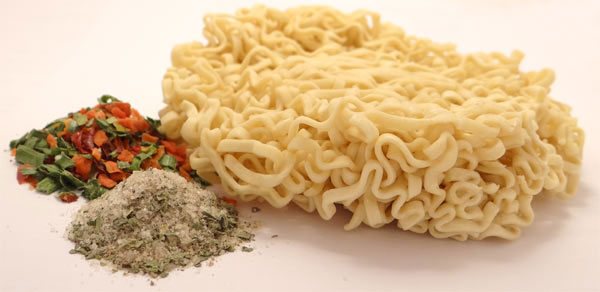
Nursing mothers should completely avoid instant noodles. There is no benefit at all to this type of pasta. And when using “chemical” seasonings, which are often included, there is a high risk of negative reactions in a newborn
The advantages of pasta dishes include:
- Affordable price.
- Quick and easy to prepare.
- Possibility of combination with various products to maintain a varied diet.
- Pleasant taste.
- A large amount of complex carbohydrates (found only in pasta made from durum wheat) saturate well and provide a lot of energy without causing spikes in blood glucose.
- In good pasta, the protein content reaches 10% - this is an excellent figure for a predominantly carbohydrate product. Protein, both animal and plant, is simply necessary for the human body.
- The production of high-quality pasta does not use harmful chemicals, dyes or preservatives. Therefore, the product is completely environmentally friendly and safe for health.
Pasta and breastfeeding
The menu of a nursing mother should contain food products that can provide the body with everything it needs and ensure a supply of necessary substances for milk production. How high-quality the milk will be and how adequate the newborn’s nutrition will be depends on the composition and calorie content of the diet.
But at the same time, every mother is not indifferent to how many kilograms her weight will change during breastfeeding. Nutritionists stubbornly add pasta to the list of prohibited foods, citing the high calorie content and low nutritional value of the dish, often not recommending pasta as a dish for a nursing mother. Upon closer examination, it turns out that this is not entirely true.
Types and composition of the product
Pasta products are divided into 3 groups, which differ in the type of wheat flour from which they are made:
- Labeling “A” - products made from durum wheat (the safest and healthiest for breastfeeding).
- Marking “B” - made from premium wheat flour.
- Marking "B" - from general purpose flour.
Pasta can be very different in shape:
- horns;
- snails;
- spirals;
- cobweb;
- noodles;
- lasagne sheets;
- shells;
- bows, etc.
Classic
Made from flour and water, sometimes salt is added. If the composition contains eggs, spices, and vegetable purees, this is no longer a classic product.
Daily norm
To eliminate depression, increased irritability and to obtain maximum benefit, it is recommended that a woman during breastfeeding consume 3-4 nuts per day. This number of nuclei has a beneficial effect on the nervous and cardiovascular systems. B vitamins improve cognitive function, give energy and increase performance throughout the day.

If you have hypertension, it is enough to consume 2-3 nuts to stabilize blood pressure. Thanks to flavonoids and antioxidants, the risk of developing a hypertensive crisis is reduced.
The optimal dosage is 30 g of macadamia per day. The maximum permissible daily intake is 11 nut kernels. It is recommended to use the product no more than once a week.
Attention!
Exceeding the daily dosage or frequent consumption of nuts can lead to excess weight. This phenomenon is due to the high calorie content of the product. 100 g of macadamia nuts has an energy value of 700-718 kcal.
Composition and types
The following is the composition of the product.
We recommend reading: Oatmeal during breastfeeding
| Name of valuable microelement | Main action |
| Vitamin B1 | Improving memory, mood, concentration, increasing appetite, ensuring metabolic processes. |
| H | Treatment of depression, improvement of mood, appearance of nail plates, prevention of their fragility and loss. |
| B6 | Regulation of protein metabolism, therapy, prevention of central nervous system diseases. |
| B9 | Eliminate fatigue, psycho-emotional stress, irritability, restless sleep, improve blood quality. |
| E | Removing toxic elements from the body, slowing down the aging process, stabilizing hormonal levels. |
| B5 | Normalizing the functioning of the kidneys and nervous system, increasing the protective properties of the body. |
| B2 | Saturating the body with energy, helping to get rid of unwanted pounds, stabilizing the central nervous system, improving the structure of the skin. |
| PP | Ensuring normal hematopoiesis, saturating the body with energy, normalizing hormonal balance. |
| B4 | Strengthening, stimulating brain activity, stabilizing liver function, lowering cholesterol levels. |
| Ca (calcium) | Stabilization of blood pressure, strengthening of nails, bones, teeth. |
| Si (silicon) | Ensuring the elasticity of the dermis, strengthening nails and hair, normalizing the level of sugar compounds. |
| Na (sodium) | Normalization of water balance in the body, removal of harmful elements, prevention of stroke. |
| Fe (iron) | Increasing the immune properties of the body, normalizing the functioning of the gastrointestinal tract, preventing obesity, increasing hemoglobin levels, preventing the development of anemia. |
| Mg (magnesium) | Strengthening tissues, muscles, cells of the nervous system, vasodilation. |
| S (sulfur) | Strengthening muscles, improving the structure of hair, nail plates, therapy for seizures. |
| K (potassium) | Regulates fluid balance in the body, saturates brain cells with oxygen, lowers blood pressure. |
| Cl (chlorine) | Stabilization of blood pressure, elimination of swelling, improvement of liver function and cardiovascular system. |
| P (phosphorus) | Formation and strengthening of bones, tooth enamel, improvement of memory, concentration. |
The product in question can be made from soft or durum wheat. The second option is considered the most useful. In addition, such products differ in shape, length, color, and time of manufacture.
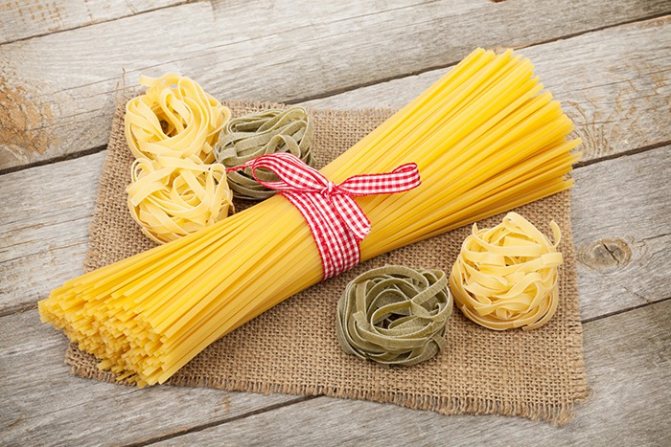
How to use during breastfeeding?
A nursing mother can eat pasta only boiled. There are a number of other rules:
- You can add a little oil, it is better to choose olive oil.
- Do not fry the product.
- Sauces can be used, but only low-fat and vegetable-based.
- You can make casseroles, but without using fatty minced meat and cheese.
- You shouldn’t think that you can’t use cheese in making pasta, but there shouldn’t be a lot of it and you should choose low-fat cheese.
- You should refrain from adding ketchup.
A breastfeeding mother can eat no more than 150 grams of pasta per day. But you shouldn’t eat them every day - the maximum weekly dose should not exceed 400 grams
It is very important to pay attention not only to how much pasta to eat and what quality it is, but also what you can combine it with. In this regard, a variety of vegetables, a small amount of low-fat cheese and dietary meat are suitable. Rabbit, lean fish and broth, turkey are perfect
Rabbit, lean fish and broth, and turkey are perfect.
What kind of pasta should a nursing mother eat?
A nursing mother should absolutely not eat thin instant noodles (forget about “Rolton” and similar student snacks). It usually contains many chemical additives that will harm both the mother’s body and the baby’s body. Pasta with hot sauces, store-bought ketchups, and fatty meats are also prohibited; they contain a lot of calories and dangerous ingredients.
How to eat pasta for a nursing mother:
- introduce pasta into your diet no earlier than a week after giving birth;
- for the first time you need to eat no more than 50 grams of food;
- After they are cooked, the pasta must be rinsed well;
- eat the dish without sauce and fatty meat, just enough stewed vegetables, champignons or grated hard cheese;
- if the child does not have a negative reaction, you can safely eat pasta, preferably durum;
- It's also good to eat noodle soup.
Rules for use during breastfeeding
Pasta is a new product for babies. Therefore, it must be introduced into the diet carefully, monitoring all changes in the condition of the baby. To do this, the first tasting is carried out from several spoons of ready-made pasta, then the volume of portions is gradually increased to the size of a small plate.

After the first month you can add:
- grated low-fat cheese;
- vegetable sauces;
- fish;
- dietary meat (chicken, turkey, rabbit).
Dressings made from mushrooms and seafood are prohibited. These are strong allergens.
Additions to pasta
Pasta with grated cheese and parsley can be eaten after the 3rd month of a child’s life. You cannot season pasta with store-bought sauce or ketchup until your baby is breastfed, because these products contain a lot of preservatives. Hard cheese, herbs, minced lean meat, boiled local fish, stewed vegetables - this is your natural and tasty pasta dressing. If we are talking about meat, then it should be lean, preferably boiled or stewed veal or turkey, or chicken and beef. Choose local varieties of fish, do not buy frozen products. Another tasty, unusual option for dressing pasta for a nursing mother is fine-grained grated cottage cheese with herbs and natural yogurt, rich in vitamins and calcium that are beneficial for a newborn.
Is it possible to eat pasta while breastfeeding in the first month and beyond?
When we ask this question, we most likely mean: “How will what we eat affect the baby, will he have any unpleasant sensations?”
Food particles can indeed pass into breast milk. In the mother's stomach, food is destroyed and absorbed into the intestinal walls in crushed form. Lunch enters the bloodstream, reaching the desired destination. The eaten paste crumbled into molecules and reached the lactocytes of the breast with the blood. These are the cells that secrete milk secretions. The group of nutrients obtained from the dish includes the protein gluten, a common allergen in children. The reaction most often manifests itself in infants as discomfort in the tummy. This is where colic, diarrhea, constipation and increased bloating come from. Symptoms may appear on the skin as peeling and redness.
If there is a reaction to wheat gluten, it will be the strongest in the first few days after birth. The layer of lactocytes at this time is not homogeneous; it allows food proteins to penetrate into the milk more freely. Later the situation changes and the barrier strengthens. Therefore, in the first month you need to listen very sensitively to the baby’s reaction to any food. Eat some new food in the 2nd or 3rd week after giving birth. Monitor your child for 24 hours. If everything is fine, eat pasta in moderation, alternating with other foods. It is not recommended to lean on them throughout the entire period of breastfeeding.
Recipes
Let's look at how you can cook pasta during breastfeeding to make the dish tasty and healthy.
- Boiled noodles.
The dish is prepared in lightly salted water; you can use a slow cooker. It is recommended to add olive or other vegetable oil, stewed vegetables, and herbs to boiled pasta. You can diversify the dish with cheese when the baby turns 3 months old. It is best to use homemade cheese sauce as a sauce, but it can be introduced 5-6 months after the baby is born. - Pasta with vegetables in a slow cooker.
This lunch or dinner is suitable for a nursing mother 4-6 months after the birth of the baby. Pour water into the bowl of the device, after boiling, add pasta, chopped onions and carrots, boil the ingredients for 15 minutes in the “Pasta” mode. Before serving, you can sprinkle the dish with parsley. - Pasta casserole with apples.
Pre-bake 3-4 apples in the oven, removing the core and skin, then peel and grind into pulp. Layer pre-boiled pasta and fruit puree into a pan greased and sprinkled with breadcrumbs, and bake in the oven at 120-150 °C for half an hour. The cooled casserole is decorated with fresh fruit.
Harmful pasta
However, there is one type of pasta that is dangerous for nursing mothers - instant noodles. The chemical elements contained in this product take a long time to be eliminated from the body, having a harmful effect on it.
Warning! During lactation, it is better to avoid pasta with meat additives. The dish is high in calories and does not bring any health benefits to a nursing woman.
If you observe moderation, then with the help of pasta you can provide the complete dietary nutrition that any mother needs during the feeding period. For example, the product will be useful with a small amount of vegetable oil and a salad of fresh vegetables.
Pasta goes well with mushrooms such as champignons and oyster mushrooms. These varieties of mushrooms, unlike many others, do not contain toxic elements, and the stomach does not feel heavy after eating them. You can make mushroom cutlets or cook pasta and mushroom soup from champignons or oyster mushrooms. Low-calorie cheeses can be added to a pasta dish; it also goes well with light homemade sauces. Although in the first month it is recommended to eat plain pasta without additives.
Useful properties of pasta
If you follow the advice of experts not to overindulge in pasta, it will only bring benefits:
- will be saturated with energy for several hours - this applies only to class “A” products (made from durum wheat);
- normalize blood sugar levels - an important advantage of complex carbohydrates over simple ones, which provoke a spike in blood sugar;
- will improve intestinal motility, help in the prevention and treatment of dysbiosis due to the high content of fiber, which is not digested, but is very necessary for beneficial bacteria in the intestines;
- saturate the body with vitamins and minerals.
Pasta is considered a dietary product. Unlike buns and cookies, they contain 70% complex carbohydrates and have a low glycemic index.
When a woman eats a plate of pasta, it gives her a feeling of fullness and a lot of energy for 3-4 hours, and the eaten bun causes an attack of hunger within 20-30 minutes.
Possible consequences of an unhealthy diet
Some mothers, having given birth to their first child, try to adhere to a milk diet, believing that this will increase milk production. In fact, breast milk comes only as much as the baby can eat. And milk has no effect on the lactation process. But excessive consumption of any products that increase lactation can lead to lactostasis or inflammation of the mammary glands.
It would be wrong to eat large quantities of oranges and tangerines, hoping that they contain much more vitamins. It is much better and healthier to eat fruits from the local climate. Familiar apples will be much more beneficial than exotic lychees or mangoes.
Some diets recommend that women limit themselves to eating meat ingredients. This is not worth doing in practice, since meat contains a large amount of necessary and beneficial substances for mother and child. Similar tips can only be applied to choosing a variety of meat products. It is not advisable to eat pork and duck during breastfeeding; these are too fatty and poorly digestible varieties.
If a mother completely limits herself to food, believing that all foods are harmful to the baby, then this will also not lead to anything good. A lack of nutrients, on the contrary, is more likely to lead to weight gain than a proper and balanced diet. Products of dubious quality can provoke negative consequences for the digestive system, causing fermentation and bloating.
The most negative consequences of an incorrect diet, of course, are problems with the child’s health. Thus, a violation of the diet by the mother can cause allergies in the baby, worsen digestion, or harm the further development of the baby with constant drinking of alcohol.
Poor nutrition of the mother or consumption of some prohibited foods does not mean that the baby is in danger or that the food consumed by the mother is completely passed on to the baby. Everything in a nursing mother's diet should be in moderation. You can drink a glass of champagne for the New Year and eat a slice of pickled cucumber at the festive table. And so that this does not affect the baby in any way, the mother can consume these products a certain time before feeding or feed the baby with pre-expressed milk reserves. All tips and recommendations relate primarily to the moderate consumption of each product, because the same forbidden green onions cope well with restoring the strength and health of a woman after childbirth. Therefore, if the mother does not have any allergic reactions to foods, then the baby is unlikely to have them.
Health benefits of macaroni and cheese
Pasta is a must-have product for a nursing mother’s diet. They include a huge number of useful components, such as:
- Vitamins B, E and PP;
- Carbohydrates;
- Proteins;
- Potassium;
- Phosphorus;
- Calcium;
- Magnesium;
- Silicon;
- Chlorine;
- Sulfur;
- Sodium;
- Iron.
All of them have a positive effect on the functioning of internal organs, physical fitness and emotional state of a person.

There is also no big ban on cheese during breastfeeding; it is healthy and easily digested by both the mother and the newborn baby. Cheeses are rich in the following elements:
- Manganese;
- Copper;
- Iron;
- Potassium;
- Vitamins A, E, C, PP and B group;
- Sodium;
- Zinc;
- Phosphorus;
- Calcium;
- Proteins;
- Carbohydrates.
It is interesting that the protein of cheese is absorbed by the child’s body much more easily than the protein of whole milk.
Important! Cheeses made with cow's milk during lactation should be treated with caution, as they can cause an allergic reaction or indigestion in the baby.
What kind of pasta should you not eat?
Not a very good combination of pasta and meat, but the benefit or harm depends on the amount of meat - digesting a large amount of protein is not an easy task for the body. However, you can eat a small piece of boiled lean chicken, beef, veal or low-fat fish. This will only have a beneficial effect on your general condition.
Mushrooms and seafood are generally not advisable when breastfeeding, so you shouldn’t combine them with anything else. In this case, the general rules for using products apply.
Here are some recipes for not only healthy, but also delicious dishes using pasta, which are recommended for nursing mothers and those who want to eat healthy.
Pasta with minced meat
Products:
- minced lean meat (chicken, veal), preferably homemade – 200 grams;
- durum wheat pasta – 400 grams;
- onion – 1 head;
- carrots (to taste) – 1 small piece;
- water 1.5 liters;
Preparation: place the minced meat, a little water and lightly salt in a heated frying pan. When the minced meat is ready, add sautéed carrots and onions. You need to sauté in a small amount of vegetable oil. Then boil the pasta in salted boiling water, cooking time is about 8-10 minutes, drain in a colander and mix with the resulting minced meat, onions and carrots. Cover with a lid and simmer over low heat for 5 minutes. Add chopped dill or parsley on top.
Pasta with cheese
Products:
- water 1.5 liters;
- pasta 400 grams;
- hard cheese 100 grams;
- fresh herbs (dill, parsley).
Preparation: Boil the pasta in salted boiling water, cooking time 8-10 minutes, drain in a colander, place on a plate and while the pasta is hot, sprinkle with finely grated cheese and sprinkle with herbs on top.
Pasta with fresh herbs
Boil the pasta, pour in olive oil and mix with finely chopped fresh herbs. It is better with dill and parsley, as they contain fewer allergens and help with lactation.
The diet of a mother who is breastfeeding her baby must be thought out in detail, because everything she eats enters the baby’s body through milk and can cause a negative reaction. It is expressed in urticaria, diathesis, diarrhea, flatulence, vomiting and nausea. If mommy wants to avoid such situations, she is advised to keep a food diary. Write down everything you tried and what reaction your baby had to this or that product. The diary should be detailed - write down the date, quantity of the new product, your baby’s reaction, even if it was absolutely neutral. If your baby has an intolerance, be sure to note what it was.
The diet of a nursing mother should be safe for the baby, as some foods can cause allergies or colic
A detailed diary will allow you to clearly understand which foods suit your child and which do not, when you start introducing this or that ingredient into your diet. Also write down the foods you plan to introduce that pediatricians and lactation specialists recommend including.
The general rules for introducing a new product into your diet are as follows:
- Eat food unfamiliar to your baby in the first half of the day, in small quantities.
- Monitor the baby’s condition for at least 2 days! Many mothers make the mistake of believing that the reaction will be visible within 2-4 hours. It happens that a rash or problems with stool appear only the next day.
- If 2 days have passed and everything is fine with the baby, you can try the new food again in a normal amount. Again, monitor the condition of the baby. Everything is fine - eat the product calmly.
What kind of pasta and when can be introduced into the diet of a nursing mother?
Pediatricians allow you to eat pasta during guards. However, during lactation, nursing women should avoid consuming instant noodles. This product contains chemical elements that negatively affect the health of the baby. This may result in an allergic reaction, stool upset or poisoning. After all, food eaten by a nursing woman enters the child's body with the help of mother's milk.
We recommend reading: Is it possible to eat pomegranate while breastfeeding?
Before introducing a new dish, young mothers need to familiarize themselves with some recommendations in order to properly consume pasta during breastfeeding. In the first months it is allowed to eat similar dishes without adding meat. For production, you can use olive oil in small quantities. If the baby tolerated the introduction of such a product well, a nursing woman can start eating pasta during breastfeeding, adding lean meat, vegetables and other products (cheeses, cream).
Nursing mothers can eat pasta during breastfeeding in the first month only in cooked form. It could be noodles, spaghetti, horns, vermicelli. The introduction should begin by consuming 60 g of the product. After this, be sure to monitor the child’s reaction for a couple of days. If the newborn does not show painful symptoms, the young mother can gradually increase the portion size to 0.2 kg. The permitted weekly intake is 0.4 kg.

If allergies, colic, or digestive disorders occur in a baby during breastfeeding, the introduction of the dish should be postponed for a couple of months, after which you can try again. Then the children's gastrointestinal tract will finally form, become stronger, and be able to better digest and assimilate new food. If a child has been identified as having an individual intolerance to gluten, then the nursing woman should completely exclude foods containing this protein from her diet.
During lactation, you should not eat pasta made by frying. It is better to boil them, bake them or cook them in a slow cooker. Also in the first 6 months. vital activity of the baby, you should avoid dishes with the addition of mushrooms. The type of meat should be lean. It is allowed to prepare soups using vermicelli, noodles based on vegetable or chicken broth. You can eat macaroni and cheese (in moderation).
In addition, you need to choose the right product. It is advisable to eat products made from durum wheat, they are the most healthy. The packaging must be sealed with intact contents.
We recommend reading: Allergenic foods for breastfeeding
A little imagination
When there is a small child or several children of different ages in the family, the mother needs to manage to feed everyone. Pasta is a very successful invention; it is great for making a quick and tasty lunch.
We need vitamins and useful elements - we cook spaghetti with vegetables, we get a vitamin dish with all the necessary elements, iron and calcium.
If you sprinkle the same spaghetti with pickled cheese or cottage cheese, we get an excellent dietary dish.
If a nursing mother can eat raw vegetables (the baby is used to them), she should prepare light vitamin-rich pasta dishes, adding chopped vegetables. We add the same vegetables to macaroni and cheese - the dish will become light and tasty.
Small boiled products, poured with hot milk, will turn into a wonderful milk soup. If eggs were added to them when making pasta, they already contain amino acids that are very necessary for the body.
There are many recipes for pasta dishes - an excellent mixture of pasta with fresh vegetables is good for a warm summer day. If you wrap a little salad of cones with vegetables in lettuce leaves, you will get an excellent vitamin-rich snack.
Several nut recipes
Culinary
During breastfeeding, women are recommended to make a berry dessert that includes macadamia nuts. It has a vitamin-mineral complex that stabilizes metabolism, hormonal and acid-base balance in the mother's body.
To prepare it you will need the following ingredients:
- 750 g strawberries, currants, blackberries, blueberries or raspberries to choose from;
- 50 g of oatmeal porridge;
- 150 g flour;
- ½ cup granulated sugar;
- 50 g nuts;
- 100 g butter.
- Berries are mixed with 2 tbsp. l. sugar and put into 4 forms.
- The remaining sugar is mixed with flour and oatmeal.
- The nuts are crushed and added to the dough.
- Add melted butter to the resulting mass and begin to knead until the dough resembles crumbs.
- The resulting mixture is coated with the berries and baked in the oven for 25 minutes at +200°C.
To quickly restore your strength and energy, it is recommended to make rice with macadamia and stewed vegetables for lunch or dinner. This dish increases the nutritional value of breast milk and facilitates the absorption of vitamins in the baby’s body.
For cooking you will need:
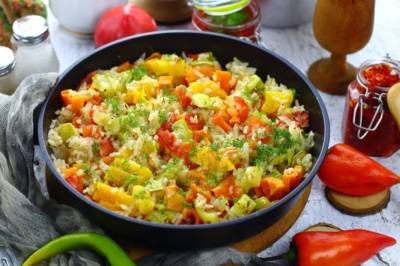
- 4 carrots;
- 250 g rice;
- 400 ml vegetable broth;
- 2 tbsp. l. vegetable oil;
- 2 macadamia nuts;
- 2 fennel roots;
- 4 tbsp. l. lemon juice;
- 2 sprigs of parsley;
- 2 zucchini;
- 2 green onions.
- The rice is washed well, filled with water and boiled until fully cooked.
- Vegetables are peeled, washed and chopped using a knife or grater, after which they are fried in vegetable oil for 6-7 minutes.
- After this time, add vegetable broth and lemon juice.
What is pasta
This product is obtained by combining wheat flour and water and then drying it. It contains a significant amount of fiber. The main beneficial ingredients are phosphorus, calcium, as well as vitamins B and PP.
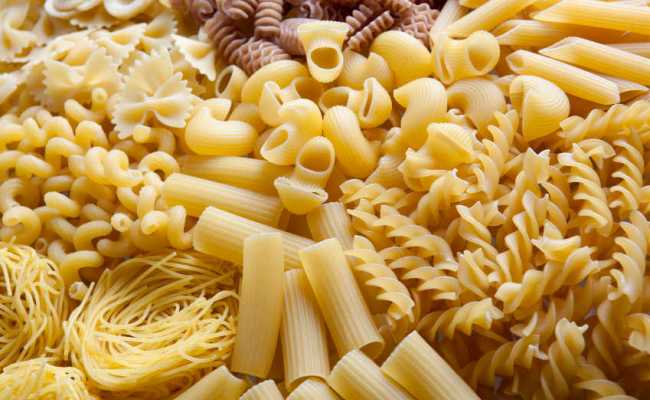
Therefore, with frequent consumption of pasta, the child’s body does not receive enough nutrients. This product is most often used to quickly saturate the nurse, but it is of little use for the child.
The beneficial properties include only the active cleansing of the mother’s body from toxins and heavy metals.
